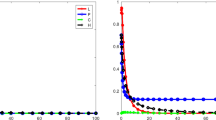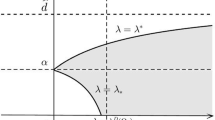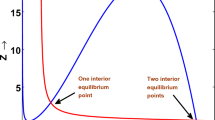Abstract
In this work, a fractional-order prey-predator system with fear effect of predator on prey population and group defense has been proposed. The existence and uniqueness of the system have been studied. Non-negativity and boundedness are also theoretically demonstrated. Analysis of local stability with examination of saddle-node and Hopf bifurcation at equilibrium points are performed by the help of numerical simulations along with analytical study. All the numerical simulations are performed using MATLAB and MAPLE.















Similar content being viewed by others
References
Malthus TR (1798) An essay on the principle of population, and a summary view of the principle of populations. Harmondsworth, Penguin
Cresswell W (2011) Predation in bird populations. J Ornithol 152(1):251–263
Svennugsen TO, Holen OH, Leimar O (2011) Inducible defenses:continuous reaction norms or threshold traits. AM Nat 178(3):397–410
Preisser EL, Bolnic DI (2008) The many faces of fear:comparing the pathways and impacts on non consumptive predator effects on prey populations. PLoS ONE 3(6):e2465
Creel S, Christianson D, Lilley S, Winnie JA (2007) Predation risk effects reproductive physiology and demography of elk. Science 315(5814):960–960
Creel S, Christianson D (2008) Relationships between direct predation and risk effects. Trends Ecol Evol 23(4):194–201
Wirsing AJ, Ripple W (2010) A comparison of shark and wolf research reveals similar behavioral responses by prey. Front Ecol Environ 9:335–341
Schmitz OJ, Beckerman AP, O’Brien KM (1997) Behaviorally mediated trophic cascades: effects of predation risk on food web interactions. Ecology 78:1388–1399
Sheriff MJ, Krebs CJ, Boonstra R (2009) The sensitive hare: sublethal effects of predator stress on reproduction in snowshoe hares. J Anim Ecol 78:1249–1258
Elliott KH, Betini GS, Norris DR (2010) Experimental evidence for within- and cross-seasona effects of fear on survival and reproduction. J Anim Ecol 2016(85):507–515
Creel S, Winnie JA, Christianson D (2009) Glucocorticoid stress hormones and the effect of predation risk on elk reproduction. Proc Natl Acad Sci USA 106:12388–12393
Mooring MS, Fitzpatrick TA, Nishihira TT, Reisig DD (2004) Vigilance, predation risk, and the Allee effect in desert bighorn sheep. J Wildl Manag 68:519–532
Tener JS (1965) Muskoxen. Queen’s Printer, Ottawa
Ivlev VS (1961) Experimental ecology of the feeding of fishes. Yale University Press, New Haven
Sokol W, Howell JA (1981) Kinetics of phenol oxidation by washed cells. Biotechnol Bioeng 23:2039–2049
Podlubny I (1999) Fractional differential equations. Academic Press, San Diego
Djordjevic VD, Jaric J, Fabry B (2003) Ann Biomed Eng 31:692. https://doi.org/10.1114/1.1574026
Ahmed E, El-Sayed A, El-Saka H (2007) Equilibrium points, stability and numerical solutions of fractional-order predator-prey and rabies models. J Math Anal Appl 325:542-1-7553
Deshpande AS, Daftardar-Gejji V, Sukale YV (2017) On Hopf bifurcational dynamical systems. Chaos Solut Fractals 98:189–198
Li X, Wu R (2014) Hopf bifurcation analysis of a new commensurate fractional-order hyper chaotic system. Nonlinear Dyn 78(1):279–288
Das M, Maity A, Samanta GP (2018) Stability analysis of a prey-predator fractional order model incorporating prey refuge. Ecol Genet Genom 7:33–46
Atangana A, Secer A (2013) A note on fractional order derivatives and table of fractional derivatives of some special functions. Abstr Appl Anal 2013:8. https://doi.org/10.1155/2013/279681
Li HL, Zhang L, Hu C, Jiang YL, Teng Z (2016) Dynamical analysis of a fractional-order predator-prey model incorporating a prey refuge. J Appl Math Comput 54(1–2):435–449. https://doi.org/10.1007/s12190-016-1017-8
Wang X, Zanette L, Zou XM (2016) the fear effect in predator-prey interactions. J Math Biol 73:1179–1204
Zhang H, Fu S, Wang W (2019) Impact of the fear effect in a prey-predator model incorporating a prey refuge. Appl Math Comput 356:328–337. https://doi.org/10.1016/j.amc.2019.03.034
Dokoumetzidis A, Magin R, Macheras P (2010) A commentary on fractionalization of multi-compartmental models. J Pharmacokinet Pharmacodyn 37:203–207. https://doi.org/10.1007/s10928-010-9153-5 discussion 217
Petras I (2011) Fractional-order nonlinear systems: modeling aanlysis and simulation. Higher Education Press, Beijing
Odibat Z, Shawagfeh N (2007) Generalized Taylors formula. Appl Math Comput 186:286-1-7293
Liang S, Wu R, Chen L (2015) Laplace transform of fractional order differential equations. Electron J Differ Equ 139:1
Kexue L, Jigen P (2011) Laplace transform and fractional differential equations. Appl Math Lett 24(12):2019–2023
Li Y, Chen YQ, Podlubny I (2009) Mittag-Leffler stability of fractional order non linear dynamic systems. Automatica 45:1965–1969
Lyapunov AM (1892) The general problem of the stability of motion. Kharkov Mathematical Society, Kharkov
Klimek M, Błasik M (2012) Existence and uniqueness of solution for a class of nonlinear sequential differential equations of fractional order. Centr Eur J Math 10:1981–1994
Haubold HJ, Mathai AM, Saxena RK (2011) Mittag-Leffler functions and their applications. J Appl Math 298628. arXiv:0909.0230 [math.CA]
Mainardi F (2014) On some properties of the Mittag-Leffler function \( E_{\alpha,1}(-\eta t^{\varepsilon })\), completely monotone for \(t > 0\) with \(0 < \varepsilon < 1\). Discrete Contin Dyn Syst Ser B 19(7):2267–2278. https://doi.org/10.3934/dcdsb.2014.19.2267
Choi SK, Kang B, Koo N (2014) Stability for caputo fractional differential systems. Abstr Appl Anal. https://doi.org/10.1155/2014/631419
Diethelm K, Ford NJ, Freed AD (2002) A predictor-corrector approach for the numerical solution of fractional differential equations. Nonlinear Dyn 29:3–22
Diethelm K (2003) Efficient solution of multi-term fractional differential equations using P(EC)mE methods. Computing 71(4):305–319
Garrappa R (2010) On linear stability of predictor-corrector algorithms for fractional differential equations. Int J Comput Math 87(10):2281–2290
Leonov GA, Kuznetsov NV (2007) Time-Varying Linearization and the Perron effects. Int J Bifurc Chaos 17(4):1079–1107
Andrews JF (1968) A mathematical model for the continuous culture of microorganisms utilizing inhibitory substrates. Biotechnol Bioeng 10:707–723
Das S (2007) Functional fractional calculus for system identification and controls. Springer, Berlin
Delavari H, Baleanu D, Sadati J (2012) Stability analysis of Caputo fractional-order non linear system revisited. Non linear Dyn 67:2433–2439
Hilfer R (ed) (2000) Applications of fractional calculus in physics. World Scientific Publishing Co., Inc, River Edge
Kilbas A, Srivastava H, Trujillo J (2006) Theory and application of fractional differential equations. Elsevier, New York
Miller KS, Ross B (1993) An introduction to the fractional calculus and fractional differential equations. Wiley, New York
Sabatier J, Agrawal OP, Tenreiro Machado JA (2007) Advances in fractional calculus: theoretical developments and applications in physics and engineering. Springer, Berlin
Simon T (2015) Mittag-Leffler functions and complete monotonicity. Integral Transforms Spec Funct 26(1):36–50
Stamova I, Stamov G (2017) Functional and impulsive differential equations of fractional order: qualitative analysis and applications
Acknowledgements
The authors are grateful to the anonymous referees, Prof. Jian-Qiao Sun (Editor-in-Chief) for their careful reading, valuable comments and helpful suggestions, which have helped them to improve the presentation of this work significantly.
Author information
Authors and Affiliations
Corresponding author
Rights and permissions
About this article
Cite this article
Das, M., Samanta, G.P. A prey-predator fractional order model with fear effect and group defense. Int. J. Dynam. Control 9, 334–349 (2021). https://doi.org/10.1007/s40435-020-00626-x
Received:
Revised:
Accepted:
Published:
Issue Date:
DOI: https://doi.org/10.1007/s40435-020-00626-x




